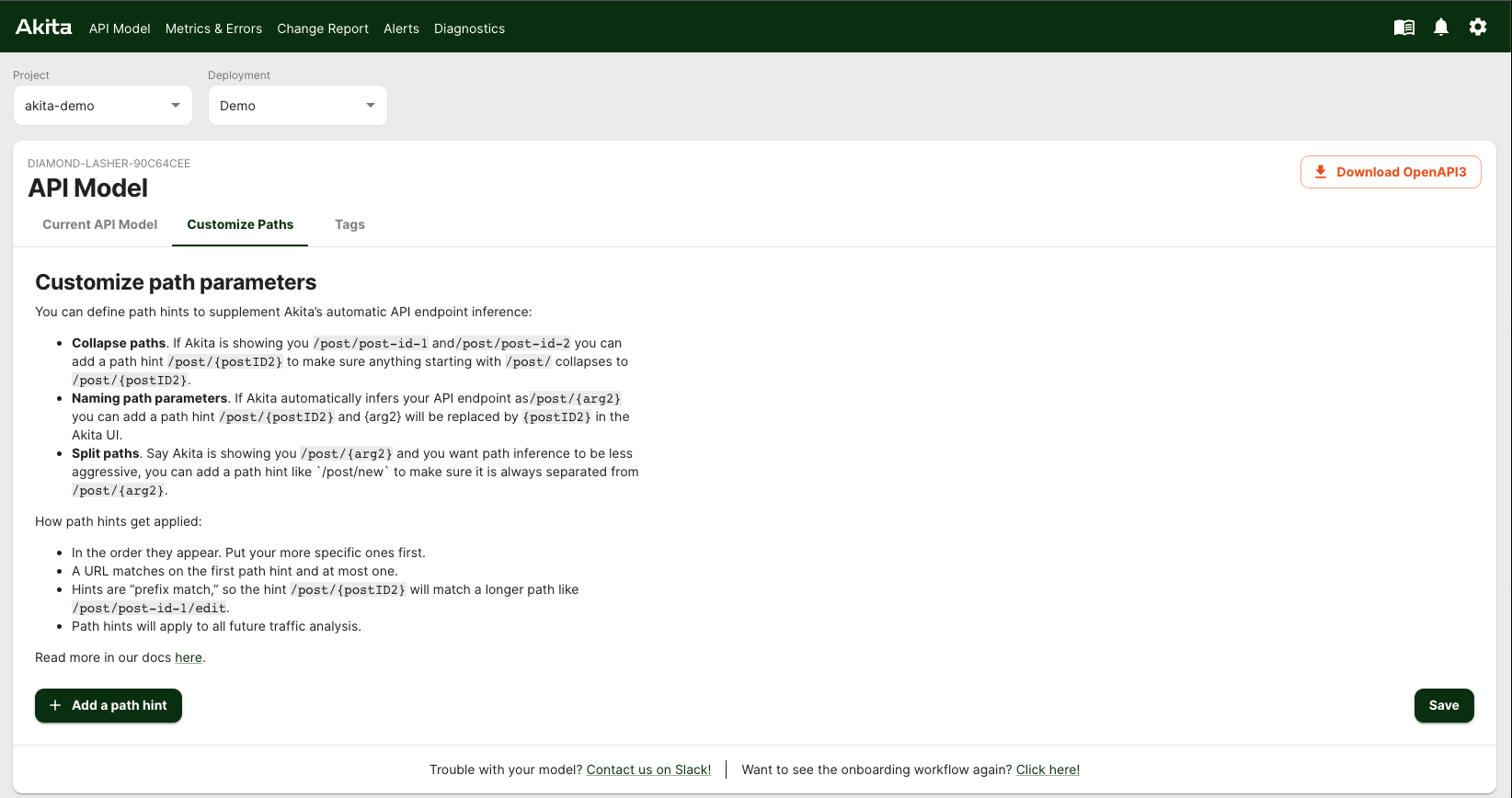Customize Path Parameters
You can customize your paths in the Akita console, via the "Customize Paths" tab of the API Model page.

The "Customize Paths" tab allows you to define and add path hints to Akita's path inference algorithms.

Path Hints
Path hints allow you to alter your API model so you see the information you care most about more clearly. You can:
- Collapse paths
- Name path arguments for better readability
- Combine split paths, and
- Separate combined paths
Collapse paths
If you have multiple endpoints showing up that are really iterations of a single endpoint, you can collapse the iterations to a single endpoint for a specific host. If you have multiple hosts with the same paths, you will need to create a separate path hint for each of them.
For example, if Akita is showing you /post/post-id-1, /post/post-id-2, /post/post-id-3, and /post/post-id-4, you would add a hint /post/{postID} to collapse those paths for all new traffic Akita observes. Adding this hint causes any path beginning with /post/... to be collapsed going forward.
If you had the same paths on additional hosts, you would need to create a path hint for each of them.

Name path arguments
The Akita inference algorithm will display arguments as {arg}. If you want to display what the argument is or does, you need to create a path hint to rename {arg} to something more descriptive and helpful to you and your team.
For example, if Akita parses your API as /post/{arg} you can add an annotation /post/{postID} and {arg} will be replaced by {postID} for all new behavior that Akita observes. Adding this hint causes any path beginning with /post/{arg}/... to be renamed going forward.

If you have the same arguments on additional hosts, you will need to create a path hint for each of them.

Combine paths
If your API mixes concrete paths with parameterized paths, the Akita path inference engine will split them all out for you. If you only want to see a single path, you can indicate a split so that you only see the information you want.
For example, if your API has these paths: /post/modify, /post/delete, /post/post-id-1, /post/post-id-2, ..., then you could add the annotation /post/{post_id} which would group post/modify and /post/delete into /post/{post_id}. Adding this hint causes any path beginning with /post/... to be combined and renamed going forward.

If you have the same mix on additional hosts, you will need to create a path hint for each of them.

Separate paths
You can also use a “^” in /post/^to require that the segment not be a path parameter; in other words, instead of combining everything under /post/ into a single displayed endpoint, we will show the paths within /post/ as separate endpoints.
For example, /post/^ will separate out /post/edit and /post/share from /post/{arg}, and ensure that they do not get collapsed.
As with other path hints, you will need to apply each hint per host.
How Path Hints Get Applied
Depending on the needs of your code and your team, you might end up needing to have a lot of path hints. There are some tips and tricks to how path hints work that will help you if you have multiple hints.
Combining Path Hints
It is possible to combine path hints, however you must take care to specify them from most specific to least specific.
Taking examples from above, if your model has the paths: /post/{arg}/post-id-1, /post/{arg}/post-id-2, /post/{arg}/post-id-3, and you add a path parameter /post/{arg}/{post_id}, you will collapse the paths to the single /post/{arg}/{post_id}. You could also then rename /post/{arg}/ to /post/{post_id} and all you will see is /post/{post_id}/{post_id}.
Path hints are ‘prefix match’, and the hint /post/{postID} will match a longer path like /post/post-id-1/edit and collapse it into /post/{postID}/edit.
Ordering Path Hints
The Akita path inference engine applies path hints in order of priority. You must list more specific path hints first.
A URL matches on the first path hint that applies—and at most one path hint. For example, if you have a hint /post/{postID} and then another one on /post/{postID}/project/{projectID}, the /post/{postID}/project/{projectID} hint will never get used. If you want to use both, switch the order.

Path hints apply to future traffic only
Path hints apply to all future traffic analysis, and only to future traffic analysis.
Examples

| Annotation | Matches | Displayed as |
|---|---|---|
/post/{postID} | /post/post-id-1 /post/post-id-2/edit/post/post-id-3/project/project-id | /post/{postID}/post/{postID}/edit/post/{postID}/project/project-id |
/post/{postID}/projects/{projectID} | /post/post-id-1/project/project-id | /post/{postID}/project/{projectID} |
/post/{postID}/^ | /post/post-id-1/share/post/post-id-2/edit | /post/{postID}/share/post/{postID}/edit |
Updated over 2 years ago